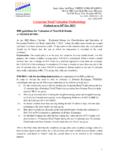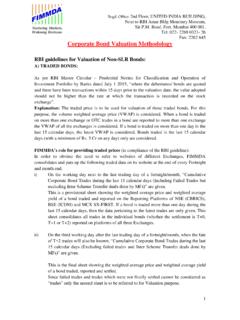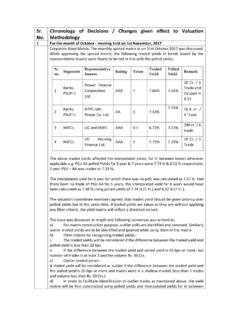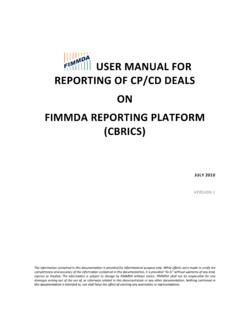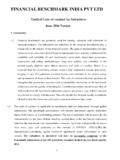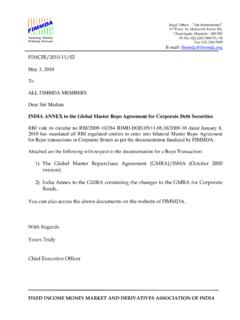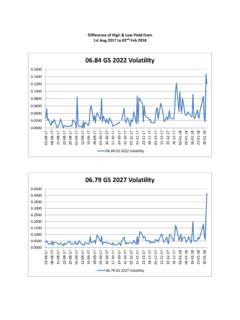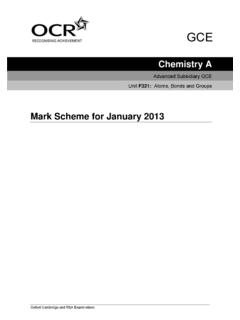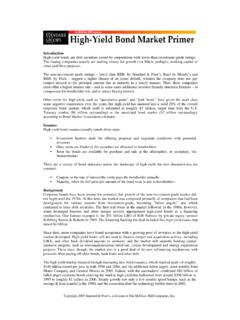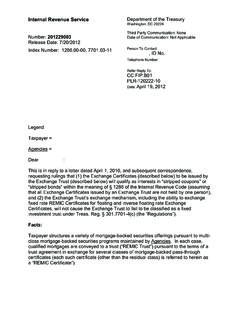Transcription of VALUING FLOATING RATE BONDS (FRBS) - FIMMDA
1 THE CLEARING CORPORATION OF INDIA V. Rajwade **Shri A. V. Rajwade is a Forex & Management ConsultantValuing FLOATING Rate BONDS ( frbs )day T-bill, refixed every 6 months, and only one refixation left, 90 days from now. Again, for the principal features of FLOATING rate BONDS sake of implicitly, we consider a 360 day be summarised simply: these are BONDS having a fixed maturity, sometimes with considering only the current FLOATING call/put options, but with the coupon refixed rate periodically with reference to a well-defined the current coupon to be 5 % , fixed benchmark (the reference rate ). The on 27/7, refixation on 27/1refixation could be daily (overnight being done on 27/10 when the T-bill linked BONDS ), or at 3/6/12 month intervals. In yield for the balance period of 3 months has international markets, the most common moved to say 6% benchmark is LIBOR.
2 In India, apart from price reverts to par on the coupon MIBOR, T-bill yields, other government bond refixation day. yields, CP yields, MIFOR, etc, are also used. In , the full price of the bond on 27/10 principle, the benchmark reference rate and will be ( ). The numerator includes refixation periods may not have the same the coupon amount due on 27/1 and the par maturity -- for example, the benchmark could price of the bond on that day. The be, say, the ruling yield on 360 day T-bill, denominator, or the discount rate, is 6% coupon to be refixed every six months. In for the balance period of 90 days as valuation is general, the FLOATING rate will be at a spread over being done on 27/10. The full price on that day the benchmark, the spread reflecting the credit works out to of the issuer, the maturity of the bond and it not necessary to consider the future its liquidity, demand for that type of coupon(s), for calculating today's price?
3 While instrument in the market etc. In India, both the coupon is not known, it could be locked GoI and corporate issuers have issued frbs . into by entering into a forward rate agreement In some ways, the valuation of FLOATING rate (3*9 in the cited case). Moreover, the money BONDS is conceptually and mathematically market/zero coupon rate for the coupon inflow more complicated than the fixed rate variety, date can be used for discounting the inflow. It particularly when the desired spread, or can be shown, however, that, under the assumed premium, over the reference rate differs from conditions, zero premium over the reference the contracted spread. rate and reversion to par value on coupon refixation day, there is no need to bring in the will consider a simple case first: a FLOATING future coupon(s) or the forward rates , for rate bond with coupon equal to yield on 180 VALUING FLOATING RATE BONDS ( frbs )12 THE CLEARING CORPORATION OF INDIA the price: the two methods give the principal now comes only at the end of 9 same answer as the following calculation months)illustrates:= + = considering the ruling 3*9 forward which is the same as calculated by using only rate, when 3 month T-bill yields 6% and the the current FLOATING rate (ignoring the rounding 270 day T-bill yields 8% difference in the 6th decimal).
4 Two zero coupon rates are The reason is simple: look at 3(d). The 6% 90 days ( )numerator is as against in the first term of 4(c) (the denominator is the same). 8% 270 days ( )However, the PV of the difference in the 3*9 months forward rate is (( ) - numerator, namely 1 discounted for 3 months, 1)*2 = , and this is the coupon 1 is , which is the same as the implied by the term structure for the period second term in 4(c).27/1 to 27/7, the maturity of the the following spreadsheet incorporating a , using the forward rate as the coupon number refixations illustrates, using the refixation rate, the full price on 27/10 is existing coupon alone, and using existing ( )+( )forward interest rates for future coupons, give (discounting inflows by the ruling money the same coupon rates , noting that (Note that, in the spreadsheet, ZCYs for the 1.))
5 Simple yields for T bills 2. ZCYs for maturities beyond 6 months -- expressed on bond equivalent basis. contracted spread = desrd sprd t .5+t 1+t +t 2+t +t ZCYs 5% Simple ZC rates Forward rates -- Coupon incl spread Simple Disc incl desrd sprd FP based on 1st cpn alone FP based on all cpns Difference % 13 THE CLEARING CORPORATION OF INDIA maturity dates of the FRB coupons need rate, and it has not changed at the time of to be used by interpolating standard maturity valuation; andZCYs. Again, in the following row, simple ZC currently desired spread over the reference rates have been calculated by converting rate is different from that originally compounding ZCYs in the earlier the first situation, we can look at row, to simple interest rates , for easy the problem of valuation from two different calculation of the forward and discount rates .
6 Perspectives: In short, where there is zero spread over the the contracted and desired spreads are reference rate, in terms of the coupon and identical, the price will revert to par on the date current market conditions, calculating the of refixation of the coupon. Therefore, it is price on the basis of the current coupon alone is sufficient if only the current coupon and the value are considered, and discounted for the balance number of days till refixation of the the methodology be different where there coupon. The discounting rate will need to be is a contracted spread over the reference rate? x% above the reference need to consider two separate situations: way of arriving at the price is to adjust is a contracted spread over the reference 1. simple yields for T bills 2. ZCYs for maturities beyond 6 months -- expressed on bond equivalent basis. contracted spread = desrd sprd t.
7 5+t 1+t +t 2+t +t ZCYs 5% Simple ZC rates Forward rates -- Coupon incl spread Simple Disc incl desrd sprd FP based on 1st cpn alone FP based on all cpns Difference % 14 THE CLEARING CORPORATION OF INDIA coupons calculated from the implied y%. In this case, the assumption of par value at forward rates , and the ZCY rates , by x% for the date of coupon refixation is not valid, since cash flow and discounting rate purposes, in the each coupon will have to yield a return different above the contracted coupon. The price therefore will differ from results are as steps for VALUING the bond in these It will be noticed that there is a minor circumstances would be as under:difference in the prices under the two methods. The reason is that the discounting of cash flows the future coupons, inclusive of the has been done at a rate different from the one contracted spread, based on the forward rates used for calculating the forward rates , because implied by the term the spread over the reference rate.
8 The first these at the zero coupon rates method, using only the current coupon, is applicable for the date of receipt of the inflow, more correct because, when the contracted and plus the desired spread which is y% spreads are equal, the price reverts to par full value then is the sum of the present on coupon of all the coupons and the face now look at the remaining situation where 10. A spreadsheet with x = 1% and y = 2% is the contracted spread is x% over benchmark the desired spread at the time of valuation is 1. simple yields for T bills 2. ZCYs for maturities beyond 6 months -- expressed on bond equivalent basis. contracted spread = desrd sprd t .5+t 1+t +t 2+t +t ZCYs 5% Simple ZCrates Forward rates -- Coupon incl spread Simple Disc incl desrd sprd FP based on 1st cpn alone FP based on all cpns Difference % 15 THE CLEARING CORPORATION OF INDIA will be noticed that, in this case, the price one of the largest issuers of FLOATING rate BONDS , based only on the current coupon differs the Italian government's pricing of such BONDS significantly from that using all the inflows was based on the model.
9 However, this pricing based on the implied forward rates . Arguably, model requires two major assumptions to be the latter is the more correct full price as the made in terms of the future coupons:assumption of price reverting to par on coupon othe current ( at the time of valuation) value refixation, which is implicit in the former, is of the benchmark interest rate will continue invalid in present case. through the life of the bond ; and12. What has been described in paragraphs 8, 9, 10 othe market expectations of margin over the and 11 above is a rigorous system based on the benchmark would also remain of bond pricing. In practice, however, it Fama's model can be used because the final is not used by market practitioners. Apart from value of the principal amount of the bond is its complexity (which can be easily taken care of known; by definition, it is the face value. From by specialised software), the reason for its not this, using the cash flows as given by the current being used in the market is the need for value of the benchmark plus the contracted interpolation of zero coupon curves for the spread over benchmark, discounted at the coupon inflow dates.
10 There is no uniformity in benchmark plus the desired spread, gives the market practice in respect of the interpolation present value. It should be noted however that techniques to be used for drawing yield curves. if the valuation is being done on a date other There are various techniques from simple than the coupon refixation date, the first linear, logarithmic, least square polynomials, coupon, which is known, would need to be cubic splines, regression models, etc. All these discounted at the current value of the lead to different interpolated numbers, often benchmark plus the desired spread, that too for differing from each other significantly. the fraction for the interest period which is still alternate approach: Calculating issue priceto run before refixation of the coupon. The Eugene Fama, well known for his pioneering mathematical derivation of the price formula is work in formulating the efficient market described below: theory, developed an equation for the expected Notation usedprice of an asset at a future date based on its P-price on issue date;0current price and the return expected by the P-price on next coupon refixation date;1investor from now until the future date; the investor will not make the investment at the r-ruling reference ratecurrent price unless his expectations of the x-contracted spread over reference rate; andfuture price satisfy his desired rate of return y-desired spread over reference ratefrom the of periods to maturityThis approach to future prices can be used to (r, x, y in fraction; face value 1)develop a model for the current, or issue, price Therefore, of a FLOATING rate bond .

